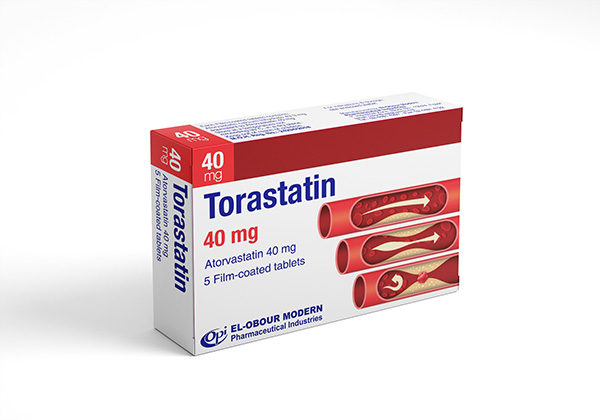Torastatin 40 mg
Torastatin 40 is the trade name of Atorvastatin calcium. an antihyperlipidemic.
Each Torastatin 40 Film Coated Tablet contains Atorvastatin 20 and 40 mg respectively.
CHEMISTRY
Atorvastatin calcium is: [R-(R*, R*)]-2-(4-Fluorphenyl)-ß,d-dihydroxy-5-(1-methylethyl)-3-phenyl-4-[(phenylamino)-carbonyl]-1H-pyrrole-1-heptanoic acid, calcium salt (2:1) trihydrate
CLINICAL PHARMACOLOGY
Atorvastatin inhibits HMG-CoA reductase and cholesterol synthesis in the liver and increases the number of hepatic LDL receptors on the cell surface to enhance uptake and catabolism of LDL and thereby producing a decrease in plasma cholesterol and lipoprotein concentrations. Atorvastatin also decreases LDL production and the number of LDL particles. Atorvastatin reduces total-C, LDL-C, apo B, VLDL-C, and triglyceride levels. It also produces an increase in HDL-C.Atorvastatin is rapidly absorbed with absolute bioavailability of approximately 12%. The rate and extent of absorption of Atorvastatin is decreased when given with food. It has very high protein binding (> 98%). In vitro studies show that atorvastatin is metabolized by cytochrome P450 3A4. It is primarily eliminated by the fecal route while the renal route comprises less than 2% of elimination.
INDICATIONS
-Adjunct to diet to reduce elevated total-C, LDL-C, apo B, and triglyceride levels in patients with primary hypercholesterolemia and mixed dyslipidemia.
-Adjunct to diet in treatment of patients with elevated serum triglyceride levels.
Adjunct to other lipid-lowering treatments in patients with homozygous familial hypercholesterolemia in order to reduce total-C and LDL-C.
DOSAGE
Atorvastatin should be used cautiously in patients who consume a substantial amount of alcohol and history of liver disease. Usual adult dose -Primary hypercholesterolemia and mixed dyslipidemia: Initiate dose at 10 mg daily. The dosage range is 10 to 40 mg once daily. Dose adjustment should be every 4 weeks or more. -Homozygous familial hypercholesterolemia: 80 mg / day. Usual pediatric dose Homozygous familial hypercholesterolemia: Treatment experience with atorvastatin is limited. Notes: After initiating or changing dose, lipid concentrations should be measured within 4 weeks and dose adjusted as needed. Dosage can be given as a single dose at any time of the day, with or without food. The maximum daily dose is 40 mg. LDL-C level should be used to initiate and assess treatment response since the goal of therapy is to lower LDL-C. The patient should be placed on a cholesterol-lowering diet before receiving Atorvastatin and should continue on this diet during treatment with Atorvastatin.USE IN PREGNANCY
is contraindicated in pregnant women because it decreases the synthesis of cholesterol in the fetus. It can also possibly decrease the synthesis of other biologically active substances that are made from cholesterol and are essential for development of the fetus. FDA Pregnancy Category X.USE IN LACTATION
is contraindicated in breast-feeding females because cholesterol synthesis inhibition may cause serious adverse effects in the nursing infant.INTERFERENCE
INTERFERENCE WITH CLINICAL AND LABORATORY TESTS Atorvastatin mav increase serum transaminase levels. Therefore, hepatic function should be determined prior to initiation of treatment and at 6 and 12 weeks of treatment or at a dosage increase, and periodically thereafter (semiannually).Atorvastatin may increase serum creatine kinase (CK) levels. Periodic determination of serum CK values are recommended in patients developing muscle pain, tenderness, or weakness during therapy or in patients receiving azole antifungals, erythromycin, genifibrozil, cyclosporine, or niacin with atorvastatin.DRUG INTERACTIONS
-The use of atorvastatin with azole antifungals, erythromycin, fibric acid derivatives, immunosuppressive drugs including cyclosporine, or niacin (nicotinic acid) can increase risk of myopathy. -The co-administration of atorvastatin with digoxin led to an increase in steady-state plasma digoxin concentrations by 20%. Digoxin levels should be monitored. -The concomitant administration of atorvastatin with an oral contraceptive led to an increase in AUC values for norethindrone and ethinyl estradiol by 30% and 20%, respectively. In choosing an oral contraceptive, these increases should be considered. -The concomitant administration of grapefruit juice with atorvastatin increased plasma concentrations of atorvastatin. The dose of atorvastatin will have to be reduced to prevent toxicity. Plasma concentrations of atorvastatin decreased approximately 25% when colestipol and atorvastatin were co-administered. However, LDL-C reduction was greater when atorvastatin and colestipol were co-administered than when either drug was given aloneCONTRAINDICATIONS
-Hypersensitivity to Atorvastatin. - Active hepatic disease. -Unexplained persistent elevation of transaminase values in pregnancy, in breast feeding mothers and in women of childbearing potential not using adequate contraceptive measures. An interval of one month should be allowed from stopping Atorvastatin treatment to conception in the event of planning a pregnancy.HOW SUPPLIED
Carton box containing F.C. tablets in Al.-Al. Foil :- q ( 5 x 1 ) ( 5 x 2 ) ( 5 x 3 ) + pamphlet
- q ( 10 x 1 ) ( 10 x 2 ) ( 10 x 3 ) + pamphlet
- q ( 15 x 1 ) ( 15 x 2 ) ( 15 x 3 ) + pamphlet






